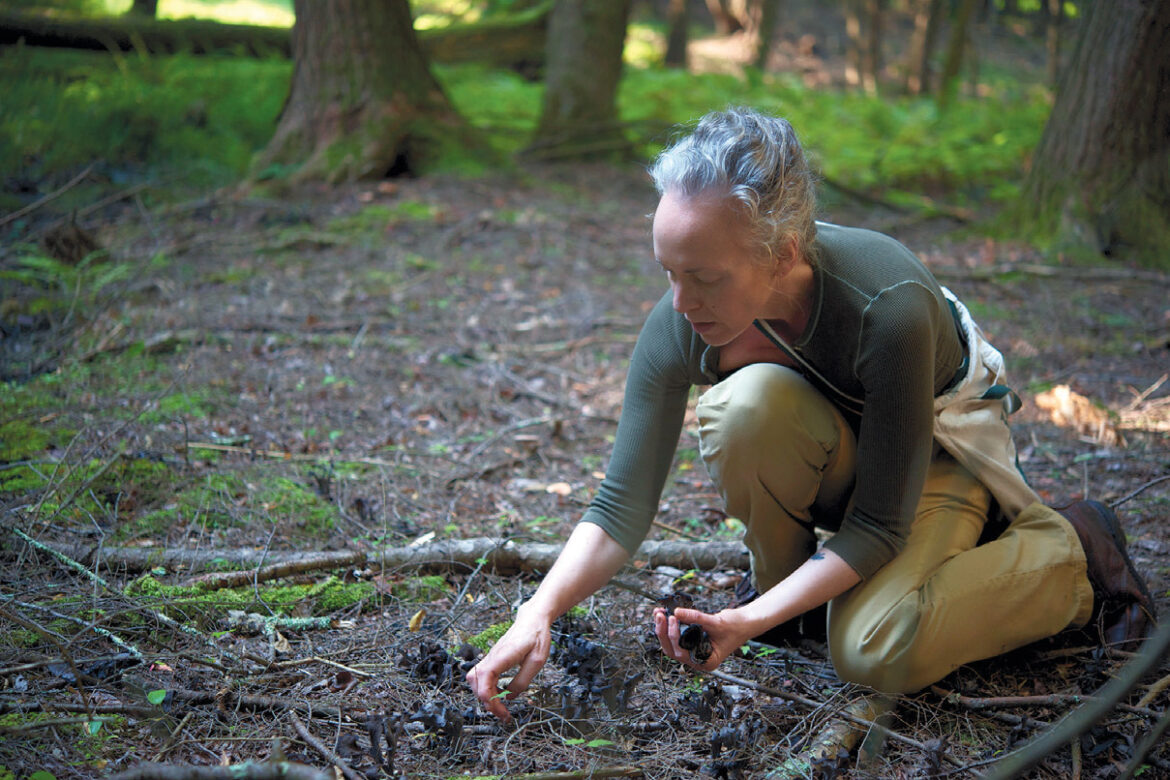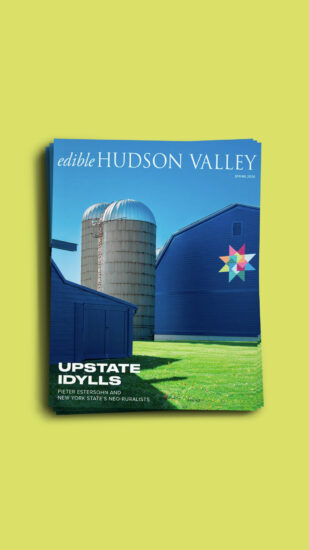Foraging always came naturally to me. During my Northern California childhood, I would climb over our back fence into an empty lot, pick great misshapen lemons off a tree that grew there and eat them sprinkled with sugar. Walking home from school, my chums and I snacked on wild blackberries, chewed juicy “sour grass” (a type of wood sorrel) and sucked drops of sweet nectar from the purple flowers of a creeping vine that covered our path. I don’t recall how we learned to do this—maybe it was innate—but I do know that I made a deep connection to nature at an early age that lay dormant during the decades I lived in New York City. It wasn’t until I started exploring the Catskills in 2003 that I began to forage again.
Though it’s gaining momentum now, at a time when slow living, “authentic” experiences and environmental awareness have captured the imagination of information-saturated millennials, foraging is not new. Once upon a time, humans survived in the world by roaming widely in search of food and provisions. This ancient practice taps into something deeply primal in all of us, and when we reconnect with nature, that lizard brain stirs. But head out into the wilderness armed with nothing more than a desire to find something edible and you will be at a loss. Depending on the season, the choicest tidbits might be in plain sight or nearly impossible to discern. Unless you know the difference, the delicious can easily be confused with the deadly.


Photo 2: Chicken of the Woods
The first guided plant walk I went on was led by Richard Mandelbaum, a practicing herbalist since 1997, who is based in Forestburgh, New York, and Brooklyn, where he is the co-founder of ArborVitae, a school of traditional herbalism. It was pouring rain that afternoon and most of our small group was kitted-out in high-performance gear. Almost at once we came upon a beautifully ruffled, bright-orange mushroom: a chicken of the woods! It’s hard to describe the thrill of that eureka moment but, for you urbanites, it’s something akin to finding money on the sidewalk or a Prada jacket in your size at half off. I have felt faint when stumbling upon a vast patch of ramps (wild leeks) and fallen to my knees in ecstasy before a flush of black trumpet mushrooms, a funnel-like mushroom that grows in clusters.
Mandelbaum’s winning combination of encyclopedic knowledge and childlike wonder was just as inspiring then as it is now, and I still regularly look to him for herbal remedies as well as plant lore. But what I remember most from that day was another member of our group, a man who, despite the torrential downpour, was roaming the forest in simple sandals and a wool sweater, rain dripping from his long beard and even longer hair. Occasionally, he would dart silently into the trees and reappear with a mushroom as though it had been calling to him. He seemed to be one with nature. This was Nathaniel Whitmore, a local herbalist and wildcrafter, and the founder and president of the Delaware Highlands Mushroom Society.
Growing up on his great-grandfather’s 100-acre farm in Damascus, Pennsylvania, Whitmore loved to wander alone through the fields and forests. He remembers his grandfather taking two mustard-smeared pieces of bread into the field in early spring to make a sandwich with young dandelion greens. As a teen, he befriended Taterbug Tyler, a local mountain man and moonshiner who introduced him to wild edibles and taught him to make tinctures, syrups and decoctions. Whitmore went on to study botany, mycology and ethnobotany, as well as Native American medicine, traditional Chinese medicine, American folk medicine and Ayurveda and now regularly offers walks and classes about botany, mushrooms and herbs.
A plant-focused omnivore, most of what Whitmore eats comes from the wild, including nuts, seeds, buds, flowers, leaves, stalks, shoots, roots, tubers, berries, fiddleheads and pollen. He attributes his good health to a diet rich in variety and from an essential connection to the earth that simply makes him feel good.
“Eating natural foods taps into something ancient, something universal, an experience that’s part of everyone’s archetypal psyche,” he explains. “Our bodies are following a trajectory set in place by our ancestors and it just feels right.” He sees the growing interest in foraging as inevitable and, without irony, gives credit to the Internet for facilitating conversation around this topic and for making plant identification more accessible.
As a full-time resident of Sullivan County, I live according to the seasons, marking the passage of time by what’s growing at local farms, in my garden and out in the wild. By the close of winter, I am checking daily for the first sign of stinging nettles, hotly anticipating the fortifying soup I will make. Summer means fermented elderflower cordial and milkweed buds in miso butter. Fall brings mushrooms— to eat and to preserve for their highly medicinal properties. I’m after that soul-satisfying connection to the earth and what Euell Gibbons called “that wild taste.” It’s in my blood.


Photo 2: Black Trumpets
Fall Foraging
Fledgling foragers are advised to carry a reliable field guide, consult an experienced mentor and heed the trusted aphorism, “When in doubt, throw it out.” It’s best to eat only a small bite of wild food that is new to you as everyone responds differently and allergy or indigestion are both possibilities. Always harvest in pristine areas that have not been sprayed or contaminated.
According to John Michelotti of Catskill Fungi, an advocate of “sustainable harvesting, leave-no-trace principles and compassion for the environment,” responsible foraging means 1) only taking what you need; 2) never harvesting more than two-thirds of any plant or mushroom; and 3) being mindful of your footprint in the wild. This also means refraining from harvesting endangered species, such as American ginseng (Panax quinquefolius).
Choice wild edibles that are relatively easy to identify include:
Maitake aka Hen of the Woods mushroom (Grifola frondosa)—Grows in clusters at the base of trees, especially oaks. Delicious in soups, batter-fried and roasted. May be frozen after cooking.
Black trumpet mushroom (Craterellus cornucopioides)— Similar to a chanterelle but ranging in color from light gray to deep black. Likes damp, mossy spots beneath beech and oak. Excellent with eggs, pasta and cream. May be dried for storage, preferably in the sun so it can soak up and store vitamin D.
Burdock (Arctium lappa)—The root of this leafy plant grows deep into the earth. (Bring tools!) Full of minerals, it makes a powerful liver tonic. Stir-fry with ginger, garlic and greens or simmer in water to make a hot tea.
Wild grapes (Vitis labrusca)—Redolent of the sweet, musky scent that defines our native species. Pick when ripe, as they will not ripen off the vine. Press them for fresh juice, which can be frozen for sorbet or made into jelly.
Staghorn sumac (Rhus typhina)—Cone-shaped drupes covered in fuzzy scarlet berries have a coating of tart malic acid. Soak in water to make a bright, lemony beverage rich in vitamin C that can be enjoyed lightly sweetened over ice.
Black walnuts (Juglans nigra)—Messy but worth the bother for their uniquely rich umami flavor. Ripe nuts will show an indentation when you press on the husk with your thumb. Hull wearing gloves as juice stains black. (Do not compost husks!) Wash hulled nuts and spread in a cool, dry area out of direct sunlight (and away from critters) for several weeks to cure. Before shelling, soak in hot water for 24 hours. Nut meats can be stored at room temp, refrigerated or frozen. They make the most divine ice cream.
Recommended Resources
- A Field Guide to Edible Wild Plants: Eastern/Central North America (Peterson Field Guides)
- A Field Guide to Medicinal Plants and Herbs: Eastern/Central North America (Peterson Field Guides)
- The Complete Mushroom Hunter: An Illustrated Guide to Finding, Harvesting, and Enjoying Wild Mushrooms by Gary Lincoff (Crestline Books)
- Stalking the Wild Asparagus by Euell Gibbons (various editions)
- Nathaniel Whitmore
- Catskill Fungi
This story was originally published in September of 2016.



